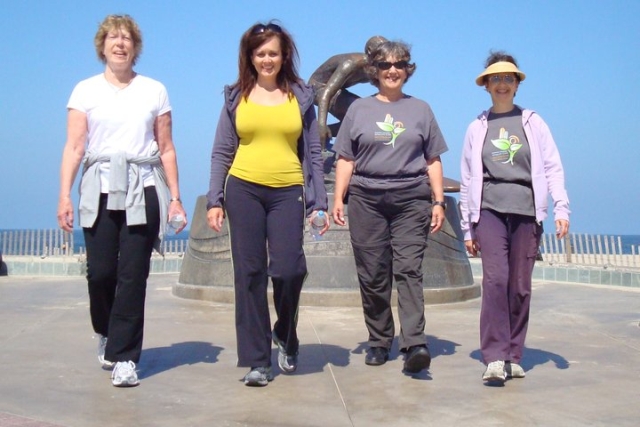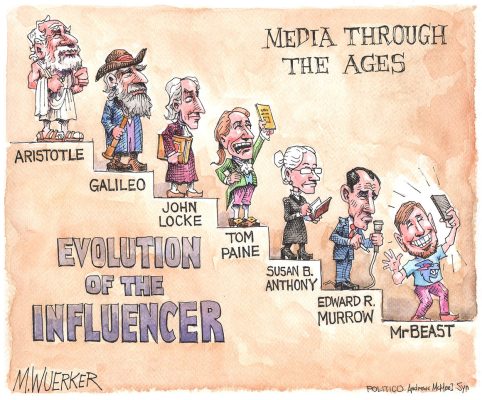The beach cities join a quest for the Holy Grail of public health: moving an entire population towards living longer, better

It is well established that Americans are large and growing larger.
According to the Center for Disease Control and Prevention, 68 percent of American adults are overweight or obese. One out of every three adults is obese, as are 17 percent of Americans aged 2 to 19. Twenty years ago, only four states had obesity rates over 20 percent; today, all fifty states do.
The upshot is that Americans are dying younger.
Even as the prevalence of smoking has decreased in the U.S., a recent University of Washington study found a decline in longevity among women in 737 out of the 3,000 counties in America – the first significant decline of its kind since the influenza epidemic in 1918. A CDC study last year found an overall dip in life expectancy as the average American lost a month of their lives, from 77.9 to 77.8 years – an extremely rare occurrence in industrial nations. If obesity rates continue to grow, the National Institute on Aging projects a loss of five years in life expectancy throughout the U.S.
The beach cities are not an exception. According to a survey conducted late last year by Gallup, 60 percent of beach cities residents are overweight, a figure believed to be conservative since it relied upon self-reporting.
Beach Cities Health District chief medical officer Lisa Santora said the survey revealed a reality counter to local perceptions.
“We are such a beach-oriented town, yet 60 percent of beach cities residents are overweight or obese,” Santora said. “A lot of people, when they hear this, are taken aback – they have a conception of us as the volleyball players you see at the beach, or the people riding bikes on the Strand. Healthy behaviors are often the most visible behaviors.”
Obesity rates in the beach cities were not the most shocking numbers in the poll, which is part of a national measurement called the Gallup-Healthways Well-Being Index (WBI) and was conducted locally as part of the Vitality City public health initiative. The WBI provides daily snapshots of 188 U.S. cities, surveying Americans’ physical and emotional health, lifestyle behaviors, work environments, life evaluations, and access to food, shelter, and healthcare.
The Well-Being Index showed some positive aspects of life in the beach cities: 92 percent of residents had enough money for food, 93 percent had health insurance, and 94 percent reported having enough money for housing.
But the WBI data, which was presented at a Vitality City press conference in Manhattan Beach in March, also showed troubling aspects of life in the beach cities. It revealed high levels of stress, anger, and worry – the beach cities ranked 176 out of 188 cities in stress, 160th in anger, and 178th in worry.
By way of national comparison, the beach cities are angrier than Detroit and as stressed out as New Orleans.
“If you think about it, these are pretty scary numbers,” said John Harris, a vice president with Healthways, the employment health company that partners with Gallup in producing the Well-Being Index.
Thus Vitality City. The project grew out of a five-year National Geographic study led by explorer and writer Dan Buettner that explored the world’s “Blue Zones,” the areas where people live the longest and with the least ill-health. In a series of articles and a subsequent book (The Blue Zones: Lessons for Living Longer from the People Who’ve Lived the Longest), Buettner developed what he called his “Power9” principles, or habits, for living better. They included mostly simple suggestions, such as “move naturally” – that is, rather than dedicating yourself to a gym regiment, find ways to live a more physically active lifestyle as part of your daily routine – eat more vegetables and fruits, and reduce your calorie intake by 20 percent through such subtle changes as using smaller plates (see Blue Zones sidebar).
Buettner’s book was a bestseller and he became a national media star. But as he made the media rounds, he had the unsettling feeling that he all was accomplishing was the creation a short-lived fad.
“I’d go on Good Morning America and Oprah and CNN and every single time end with the Power9,” Buettner said. “I just knew for a week I was hot and everyone heard about it…but how do get people to adopt these things?”
Buettner obtained a grant to look at public health initiatives around the world and learned two things: they always failed in America, and those that were successful elsewhere in the world focused not on individual behavior but changes in the environments in which people live.
“People are nudged into healthier habits,” Buettner said. “Hence this whole Vitality City/Blue Zones movement was born.”
His word choice was not accidental. Vitality City intends to be not just a project, but a movement. It began in a little town in Minnesota named Albert Lea. In 2009, Buettner obtained a $1 million grant from AARP, assembled an “A-Team” of public health experts, and attempted to apply his Blue Zones findings in a ten-month pilot project that dubbed Albert Lea the nation’s first Vitality City. The goal was to add 10,000 years to the cumulative lifespan of the town’s 18,000 residents.
What AARP would later describe as “the Minnesota Miracle” was a startling success that flew in the face of the epidemic of ill-health spreading across the rest of America. The 3,600 residents who participated lost an average of 2.6 pounds and increased their projected life expectancy by 3.1 years (Blue Zone populations worldwide see a life expectancy 10 to 12 years longer than Americans); health care claims for city employees dropped 49 percent, and absenteeism dropped 20 percent.
“The results were stunning,” Walter Willett, chair of Harvard’s Department of Nutrition, told Newsweek magazine.
The success caught the attention of Healthways, a private company described as a “well-being provider” that works with many of the largest employers in the U.S. to cut health care costs by improving employee health. Blue Zones and Healthways joined forces and set out in search of the next Vitality City. This time, they sought a larger population and a longer project that could serve as a blueprint for national change.
Beach Cities Health District CEO Susan Burden was attending a business conference in Texas last year when she met a few representatives from Healthways. She picked up some materials about the Vitality City project and brought it back to BCHD headquarters, where she turned the matter over to Santora to investigate.
“I didn’t think too much about it, but I came back and gave it to Lisa to see if it was something we should get involved in,” Burden said. “And she wheeled into my office a couple of days later and said, ‘Absolutely!’”
Santora saw the opportunity as something akin to the Holy Grail of preventative health: never before had such tool been made available all in one place to apply to improving the health of single community. The Well-Being Index alone represented a $25 million measurement tool; Healthways had a impressive and unusual body of work improving the health of more than 35 million people worldwide; and Buettner’s Blue Zones team represented the cutting edge of public health work.
But time was short. They had three weeks to fill out a 200-page application that also required the endorsement of every elected official in Hermosa Beach, Manhattan Beach, and Redondo Beach. Somehow, they pulled it off. In a rare show of unanimous cooperation across city borders, all three school boards and city councils, the BCHD Board of Directors, and all three city managers and school superintendents signed on in support of making the beach cities a Vitality City.
“I think 36 elected or appointed city and school officials agreed,” Santora said. “We were everywhere. And I was like eight months pregnant. It was really crazy.”
They submitted the application in April of 2010. Fifty-five communities wanted to be the next Vitality City. Within a week, the BCHD was notified that the beach cities were one of three finalists. But they faced stiff competition: Asheville, North Carolina, and a group of communities in Central Florida that included Winter Park and College Park. The Florida applicants seemed the most obvious choice because they had the backing of a very powerful local employer, Disneyworld.
In June, Vitality City representatives paid a visit to the beach cities. Delegations from each city welcomed them at the Redondo Beach Performing Arts Center. Each mayor made a pitch. A tall woman dressed as a lobster danced outside the front door. Students from “Livewell Kids” – a BCHD program which teaches nutrition and gardening in Redondo Beach schools – made a presentation.
“It was a turning point,” Burden said. “We pulled out all the stops. I give a lot of credit to our elected officials.”
In September, the beach cities were officially selected as Vitality City. The community buy-in, the proximity to a major media market, and the unique framework already in place with the Beach Cities Health District – a former hospital district that has become a preventative health agency – convinced Vitality City representatives that this community was best situated to become a Blue Zone. The BCHD board agreed to invest $1.8 million over the course of three years, an amount matched with a $3.5 million investment by Healthways.
Buettner said that Albert Lea was a beginning but the beach cities will represent a giant leap forward in the Vitality City movement.
“I think we just showed them a glimpse,” Buettner said. “But the South Bay of L.A. – if we can do it here, we’ve proven to the rest of America it can be done….I just know all eyes will be on us, and we will prove we can do it.”

The “A Team” has arrived and fanned out throughout the community. Walkability and bikeability expert Dan Burden – named by Time magazine as one of the six most important civic innovators in the world – has laid out a plan to improve the built environment to make it more conducive to walking and biking. Brian Wansink, author of Mindless Eating: Why We Eat More Than We Think and director of the Cornell Food and Brand Lab, has helped local restaurants make tweaks aimed at nudging diners into healthier choices. A team of Healthway employer consultants has worked with several local businesses to create more healthful work environments, and is on call to provide this free service to any local employer.
The Vitality City “Walking Moai” program, based on an Okinawan concept that brings people together in small groups, has seen more than 100 groups form. In a few weeks, three local schools will begin “Walking Schoolbus” programs that will help kids utilize the “move naturally” concept and walk together to school.
Changes are happening. And the movement does indeed appear to be spreading. Last week, the state of Iowa launched its own five year Blue Zones/Healthways initiative in hopes of becoming the healthiest state in America.
“When Vitality City launched in the beach cities, we said our goal was to lead and ignite a city-by-city movement to transform communities throughout the country,” said Veronica Flores, the Vitality City manager for the beach cities. “The Iowa initiative shows that other communities are recognizing what the beach cities was the first to recognize…that environmental and policy changes are a critical component in motivating residents to adopt and maintain healthier lifestyles.”
Burden believes that the momentum is gathering locally.
“I think we’ve really just gotten things rolling,” she said. “We are already seeing some pretty amazing things. It’s really exciting, and I’m pretty sure the best is yet to come.”
See vitalitycity.com for more information. ER










